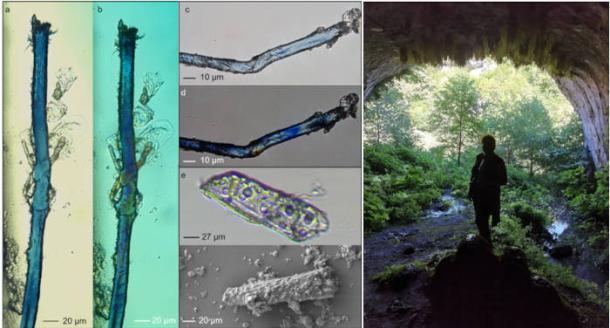Science
Discovery of Ancient Indigo Dye Challenges Understanding of Early Human Culture

An international research team has unveiled the earliest known evidence of indigo dye processing, pushing back its use by more than 30,000 years. The findings, led by researchers from Ca’ Foscari University of Venice, reveal traces of indigotin—the chemical compound that produces indigo’s vibrant blue hue—on stone grinding tools that date back 34,000 years. These artifacts were discovered in the Dzudzuana Cave located in the Caucasus Mountains of Georgia.
This groundbreaking research, published in the scientific journal PLOS One, marks the first instance of detecting the indigotin molecule on such ancient tools. The discovery significantly alters the understanding of early human interactions with plant resources, suggesting a level of botanical knowledge and processing sophistication that predates prior assumptions about early Homo sapiens.
Implications for Early Human Cultural Practices
The evidence of indigo dye usage extends our comprehension of the cognitive and cultural capabilities of Stone Age peoples. The researchers’ analysis indicates that these ancient communities not only utilized plants for food and basic survival but also engaged in complex processing methods. This suggests a rich cultural life that incorporated artistic expression long before the advent of recorded history.
Such findings highlight the importance of plants in the daily lives of early humans, who likely employed them for both functional and decorative purposes. The implications of this research stretch beyond the realm of archaeology, as it offers insights into the social and cultural dynamics of early human societies.
A New Era in Archaeological Research
The discovery at Dzudzuana Cave is part of a broader trend in archaeology, where researchers increasingly uncover evidence that challenges previously held narratives about early human behavior. The ability to process and utilize complex dyes such as indigo suggests that these communities possessed extensive knowledge of their environment, including the plants available for use.
As further studies emerge, this research could inspire a reevaluation of other ancient practices, potentially leading to new discoveries about the capabilities of prehistoric populations. The exploration of plant use in ancient times not only deepens our understanding of early human life but also raises questions about the origins of creativity and artistic expression in human history.
In summary, the identification of indigo dye processing tools dating back 34,000 years in Georgia underscores the sophistication of early human societies. As researchers continue to unravel the complexities of our ancestors’ lives, the narrative of human evolution becomes ever more intricate and compelling.
-

 Top Stories2 months ago
Top Stories2 months agoTributes Surge for 9-Year-Old Leon Briody After Cancer Battle
-

 Entertainment3 months ago
Entertainment3 months agoAimee Osbourne Joins Family for Emotional Tribute to Ozzy
-

 Politics3 months ago
Politics3 months agoDanny Healy-Rae Considers Complaint After Altercation with Garda
-

 Top Stories3 months ago
Top Stories3 months agoIreland Enjoys Summer Heat as Hurricane Erin Approaches Atlantic
-

 World4 months ago
World4 months agoHawaii Commemorates 80 Years Since Hiroshima Bombing with Ceremony
-

 Top Stories2 months ago
Top Stories2 months agoNewcastle West Woman Patricia Foley Found Safe After Urgent Search
-

 Top Stories4 months ago
Top Stories4 months agoFianna Fáil TDs Urgently Consider Maire Geoghegan-Quinn for Presidency
-

 World4 months ago
World4 months agoGaza Aid Distribution Tragedy: 20 Killed Amid Ongoing Violence
-

 World4 months ago
World4 months agoCouple Convicted of Murdering Two-Year-Old Grandson in Wales
-

 World4 months ago
World4 months agoAristocrat Constance Marten and Partner Convicted of Infant Murder
-

 Top Stories3 months ago
Top Stories3 months agoClimbing Errigal: A Must-Do Summer Adventure in Donegal
-

 Top Stories3 months ago
Top Stories3 months agoHike Donegal’s Errigal Mountain NOW for Unforgettable Summer Views









